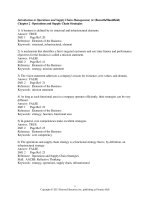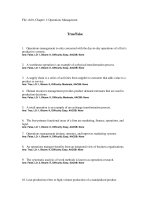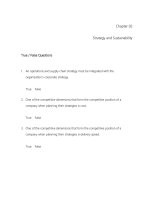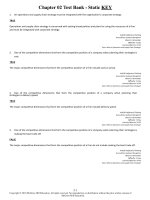Introduction to operations and supply chain management 3e bozarth chapter 14
Bạn đang xem bản rút gọn của tài liệu. Xem và tải ngay bản đầy đủ của tài liệu tại đây (554.97 KB, 33 trang )
Managing Projects
Chapter 14
Chapter Objectives
Be able to:
Explain the difference between routine business activities and
projects.
Describe the five major phases of a project.
Construct a Gantt chart and interpret the results.
Construct a project network diagram and calculate the earliest
and latest start and finish times for all activities.
Identify the critical activities and paths in a network.
Crash a project.
Copyright © 2013 Pearson Education, Inc. publishing as Prentice Hall
14 - 2
Project
Project – A temporary endeavor undertaken
to create a unique product, service, or result.
© 2008 Project Management Institute
Projects have clear starting and ending points after which
the people and resources dedicated to the project are
reassigned.
Projects are non-routine, can be large or small, and may be
difficult to manage.
Projects typically require significant levels of crossfunctional and interorganizational coordination.
Copyright © 2013 Pearson Education, Inc. publishing as Prentice Hall
14 - 3
Project Management
Project Management – The application of
knowledge, skills, tools, and techniques to
project activities to meet project
requirements.
© 2008 Project Management Institute
Copyright © 2013 Pearson Education, Inc. publishing as Prentice Hall
14 - 4
Project Management
Trends
The faster pace of strategic change
New product lines are introduced more often to fight off
competitors.
Information technology solutions become quickly out-ofdate.
Customer and supplier networks quickly change.
The changing role of middle management
The role has decreased due to more advanced information
systems handling many of the tasks.
Responsibilities given to middle managers have been pushed
down to supervisors and employees.
Copyright © 2013 Pearson Education, Inc. publishing as Prentice Hall
14 - 5
Project Phases
Concept phase
Project definition phase
Planning phase
Performance phase
Postcompletion phase
Figure 14.1
Copyright © 2013 Pearson Education, Inc. publishing as Prentice Hall
14 - 6
Project Phases
Concept Phase
Broad definition and scope
Budget estimates within 30%
Project definition Phase
Tentative schedules and budgets, organization, key
personnel and resource requirements
Budget estimates refined within 5% to 10%
Copyright © 2013 Pearson Education, Inc. publishing as Prentice Hall
14 - 7
Project Phases
Planning phase
Detailed plans, timing, budgets and resources
Milestones
Project management tools and techniques
Performance phase
Execution and control
Postcompletion phase
“Wrap-up”
Reassignment of project resources
Copyright © 2013 Pearson Education, Inc. publishing as Prentice Hall
14 - 8
Project Management Tools
Gantt charts – Graphical tools used to show
expected start and end times for project activities
and to track actual progress against these time
targets.
Network diagrams – Graphical tools that show the
logical linkages between activities in a project.
Copyright © 2013 Pearson Education, Inc. publishing as Prentice Hall
14 - 9
Gantt Charts
Table 14.2
Activities can occur simultaneously and some have
predecessors that must be completed beforehand.
Copyright © 2013 Pearson Education, Inc. publishing as Prentice Hall
14 - 10
Gantt Charts
Figure 14.2
Shows that the project should be completed by the end
of Week 18 and when specific activities should
start and finish.
Copyright © 2013 Pearson Education, Inc. publishing as Prentice Hall
14 - 11
Network Diagrams
Critical-path method – A network-based technique
in which there is a single time estimate for each
activity.
Program evaluation and review technique (PERT) –
A network-based technique in which there are
multiple time estimates for each activity.
Copyright © 2013 Pearson Education, Inc. publishing as Prentice Hall
14 - 12
Constructing a Network Diagram
Identify each unique activity in a project by a capital letter that
corresponds only to that activity.
Represent each activity in the project by a node that shows the estimate
length. (Activity on node (AON) diagram.)
If an activity has an immediate predecessor(s), show the relationship by
connecting the two activities with an arrow.
Determine the earliest start time (ES) and earliest finish time (EF) for each
activity by performing a forward pass.
Determine the latest finish time (LF) and latest starting time (LS) for each
activity by doing a backward pass.
Determine the critical activities and path(s) in the project.
Copyright © 2013 Pearson Education, Inc. publishing as Prentice Hall
14 - 13
Network Diagrams
Critical path – A network path that has the longest, or is tied
for the longest, linked sequence of activities.
Project duration – The duration of a project is equal to the
duration of the critical path.
Network path – A logically linked sequence of activities in a
network diagram.
Critical activities – Project activities for which the earliest
start time and latest start time are equal.
Copyright © 2013 Pearson Education, Inc. publishing as Prentice Hall
14 - 14
AON Example – Gina3000
Use the following data to develop a network
diagram:
Copyright © 2013 Pearson Education, Inc. publishing as Prentice Hall
14 - 15
AON Example – Gina3000
Network Diagram
Figure 14.4
Copyright © 2013 Pearson Education, Inc. publishing as Prentice Hall
14 - 16
AON Example – Gina3000
Identify the Paths:
ACFGJ
ACDEGJ
ACDEHJ
ACDEIJ
BCFGJ
BCDEGJ
BCDEHJ
BCDEIJ
Copyright © 2013 Pearson Education, Inc. publishing as Prentice Hall
14 - 17
AON Times and Slack
Earliest Start Time (ES)
= Latest EF for all immediate predecessors
Earliest Finish Time (EF)
= ES + activity’s duration
Latest Start Time (LS)
= LF – activity’s duration
Latest Finish Time (LF)
= Earliest LS for all immediate successors
Slack = amount of allowable delay in an activity
= Equal to LS – ES or LF – EF for an activity
Copyright © 2013 Pearson Education, Inc. publishing as Prentice Hall
14 - 18
AON Example – Gina 3000
Table 14.3
Calculate Earliest Start and Earliest Finish Times
Copyright © 2013 Pearson Education, Inc. publishing as Prentice Hall
14 - 19
AON Example – Gina 3000
Table 14.4
Calculate Latest Start and Latest Finish Times
Copyright © 2013 Pearson Education, Inc. publishing as Prentice Hall
14 - 20
AON Example – Gina 3000
Identify the Critical Path(s)
ACFGJ = 13 weeks
ACDEGJ = 17 weeks
ACDEHJ = 17 weeks
ACDEIJ = 17 weeks
BCFGJ = 14 weeks
BCDEGJ = 18 weeks
BCDEHJ = 18 weeks
BCDEIJ = 18 weeks
The activities in these critical
paths have no slack.
The project should be completed
in 18 weeks.
Copyright © 2013 Pearson Education, Inc. publishing as Prentice Hall
14 - 21
Crashing a Project
Crashing a Project – Shortening the overall duration
of a project by reducing the time it takes to perform
certain activities.
List all network paths and their current lengths and mark all activities
that can be crashed.
Focus on the critical path or paths. Working one period at a time,
choose the activity or activities that will shorten all critical paths at the
least cost. The one rule is this: Never shorten an activity that is not on
a critical path, regardless of the cost. Doing so will not shorten the
project; it will only add costs.
Recalculate the lengths of all paths and repeat step 2 until the target
project completion is reached or until all options have been exhausted.
Copyright © 2013 Pearson Education, Inc. publishing as Prentice Hall
14 - 22
Crashing Example 14.3
Courter Corporation
Use the following data to develop a schedule to complete
the project within 23 weeks:
Table 14.5
Copyright © 2013 Pearson Education, Inc. publishing as Prentice Hall
14 - 23
Crashing Example 14.3
Courter Corporation
Network Diagram:
Figure 14.6
Copyright © 2013 Pearson Education, Inc. publishing as Prentice Hall
14 - 24
Crashing Example 14.3
Courter Corporation
Calculate ES, EF, LS, and LF for each activity
* Critical Activity
Note: Critical Activities have a Slack = 0
Table 14.6
Copyright © 2013 Pearson Education, Inc. publishing as Prentice Hall
14 - 25









